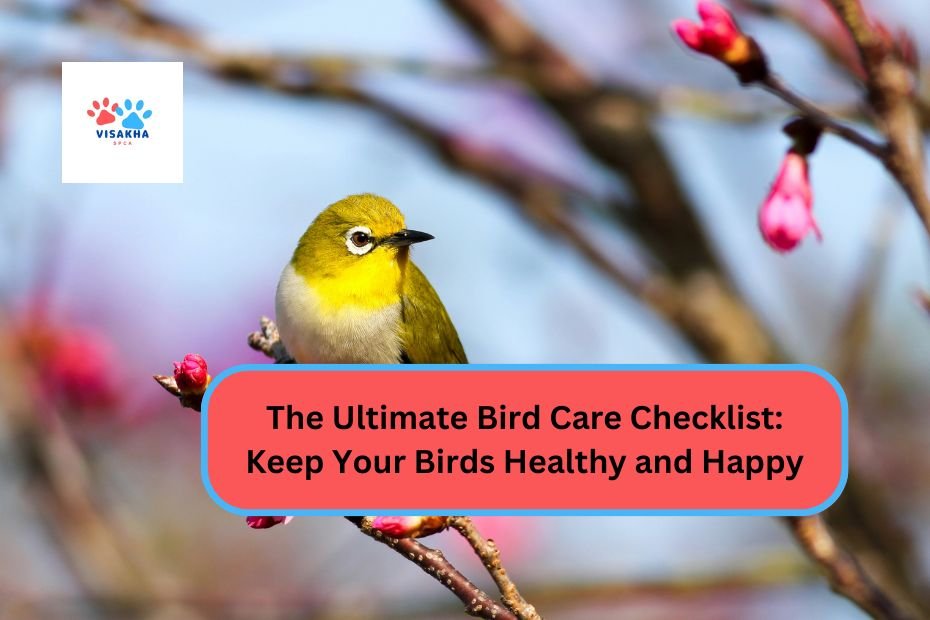Owning a bird can be a rewarding experience, but it also comes with the responsibility of ensuring their health and happiness. To help you provide the best care for your feathered friends, here’s the ultimate bird care checklist. This comprehensive guide covers everything you need to maintain a thriving environment for your birds.
1. Cage and Environment
Cage Size
- Minimum Size: Ensure the cage is large enough for your bird to spread its wings fully and move around comfortably.
- Cage Type: Choose a cage with horizontal bars for climbing.
Cage Placement
- Location: Place the cage in a well-lit area, away from drafts and direct sunlight.
- Accessibility: Ensure the cage is easy to access for cleaning and interaction.
Cage Accessories
- Perches: Provide multiple perches of various sizes and materials to promote foot health.
- Toys: Include a variety of toys to stimulate mental activity and prevent boredom.
- Food and Water Dishes: Use stainless steel or ceramic dishes that are easy to clean and refill.
2. Diet and Nutrition
Balanced Diet
- Pellets: Provide high-quality pellets that should make up the majority of their diet.
- Fresh Foods: Offer a variety of fresh fruits and vegetables daily.
Seed Mix
- Limited Use: If feeding seeds, use them as a treat rather than the main food source.
- Nutritional Quality: Choose seed mixes that are fresh and free of preservatives.
Hydration
- Fresh Water: Provide clean, fresh water daily; consider a water bottle to prevent contamination.
- Hydration Sources: Include watery fruits (like watermelon) in their diet for extra hydration.
3. Socialization and Interaction
Daily Interaction
- Playtime: Dedicate time each day for interaction, whether through play, training, or simply talking to them.
- Socialization: Encourage friendly behavior by introducing them to different environments and gentle handling.
Companionship
- Solo Birds: If you have a single bird, consider spending extra time with them or getting a companion bird of the same species.
- Group Birds: If you have multiple birds, ensure they are compatible to avoid stress or fighting.
4. Health and Wellness
Regular Veterinary Check-ups
- Annual Visits: Schedule yearly check-ups with an avian veterinarian to monitor health.
- Be Observant: Monitor for signs of illness, such as changes in appetite, behavior, or droppings.
Grooming
- Feather Care: Regularly check feathers for signs of molting or external parasites.
- Beak and Nail Trimming: Trim beaks and nails as needed or consult a vet for professional grooming.
Bathing
- Water Access: Provide opportunities for bathing, either through a shallow dish or misting with water.
- Humidity: Consider a humidifier in dry environments to promote healthy skin and feathers.
5. Environmental Enrichment
Toys and Activities
- Variety: Rotate toys regularly to keep your bird engaged and prevent boredom.
- Foraging Opportunities: Hide treats or use foraging toys to encourage natural behaviors.
Safe Space for Exercise
- Free Flying Time: Allow your bird to fly outside the cage in a safe, bird-proofed area.
- Supervised Play: Monitor their playtime outside the cage to ensure safety from potential hazards.
6. Cleaning and Maintenance
Cage Cleaning
- Daily Tasks: Remove uneaten food and change water daily.
- Weekly Deep Clean: Clean the entire cage, including perches, toys, and dishes, using safe, non-toxic cleaners.
Air Quality
- Ventilation: Ensure proper ventilation in the room where the cage is located.
- Avoid Toxins: Keep the area free of smoke, strong perfumes, and toxic plants.
7. Safety Precautions
Hazard Awareness
- Bird-Proofing: Remove potential hazards such as toxic plants, open windows, and small objects they might swallow.
- Electrical Safety: Secure electrical cords and outlets to prevent chewing.
Emergency Preparedness
- Vet Information: Keep the contact information for your avian vet handy.
- Emergency Kit: Prepare a small kit with essential supplies, including a first-aid manual, gauze, and any necessary medications.
8. Training and Behavior
Basic Training
- Commands: Teach basic commands like “step up” or “come” using positive reinforcement.
- Behavioral Training: Address any behavioral issues, such as biting or screaming, through consistent training.
Bonding Activities
- Trust-Building: Spend time just sitting near your bird to help them get used to your presence.
- Interactive Play: Use toys that require interaction to build a bond while providing mental stimulation.
Conclusion
By following this ultimate bird care checklist, you can ensure your feathered friends are healthy, happy, and thriving in their environment. Owning a bird is a commitment that requires time, knowledge, and love. Regular attention to their dietary needs, socialization, health, and overall environment will lead to a fulfilling companionship that both you and your bird will cherish. Remember, a well-cared-for bird not only enriches your life but also has the potential for a long and happy life as your companion!

